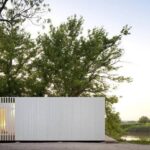Jul 05, 2013 • Small House
Meet DALE, the Net-Zero Expandable Micro-Home

This concept home comes from the creative minds of students studying at the Southern California Institute of Architecture (SCI-Arc) and the California Institute of Technology (Caltech). The two institutions have been working in conjunction with one another to produce this net-zero micro-home concept for the 2013 Solar Decathlon.

Called DALE (Dynamic Augmented Living Environment), this super efficient home is able to expand in size according to your needs. DALE consists of two main living modules that are set on rails allowing them to separate and create a sheltered courtyard space (the solar canopy is optional). The rail system allows the home to increase in size from 600 sq ft to almost 1,800 sq ft!
One of the modules contains two bedrooms, a living area, and a multi-purpose space that can be utilized, for example, as an office. The second module houses all the ‘mechanical’ functions of the home, including the kitchen, bathroom and a room which stores all the technology required to make the home net-zero.

From Gizmag:
“Electricity is delivered via solar panels and an inverter, while an outdoor condenser can be used to extract heat from the outside air, or expel heat from the house. A solar hot water tank also provides hot water, and an energy monitoring system will be installed to allow occupants to keep a close eye on their energy usage.”

The SCI-Tech and Caltech students are aiming to have a prototype ready by August which will allow them to test and fine-tune their design in time for the US Department of Energy-sponsored Solar Decathlon.

I have always been a proponent for passive design over the use of active renewable energy systems (mainly due to their high embodied energy and cost) but when the passive techniques and renewable technologies are combined we can create carbon neutral, net-zero, and even in some cases, carbon negative structures.
I believe the future of buildings is inevitably going to err towards the widespread implementation of sustainable materials and renewable systems; we simply don’t have a choice. Our homes may well become ‘living buildings’ powered by algae as demonstrated by the BIQ building in Hamburg, Germany. Yes, the future’s bright, the future’s… green.
Via Gizmag
Join Our Newsletter And
Get 20% Off Plans
Get the latest tiny house news, exclusive
offers and discounts straight to your inbox



